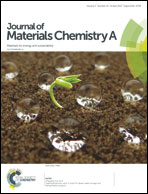Abstract
Novel hybrid batteries are fabricated using an aluminum anode, a sodium intercalation cathode Na3V2(PO4)3 (NVP), and a sodium/aluminum dual salt electrolyte based on NaAlCl4 and an eutectic mixture of 1-ethyl-3-methylimidazolium chloride (EMImC) and aluminum chloride. Cyclic voltammograms indicate that increasing the molar concentration of AlCl3 in the electrolyte is beneficial to high coulombic efficiency of aluminum deposition/stripping, which, unfortunately, results in lower coulombic efficiency of sodium extraction/insertion in the cathode. Therefore, EMImC–AlCl3 with a molar ratio of 1–1.1 is used for battery evaluation. The hybrid battery with 1.0 M NaAlCl4 exhibits a discharge voltage of 1.25 V and a cathodic capacity of 99 mA h g−1 at a current rate of C/10. In addition, the hybrid battery exhibits good rate performance and long-term cycling stability while maintaining a high coulombic efficiency of 98%. It is also demonstrated that increasing salt concentration can further enhance the cycling performance of the hybrid battery. X-ray diffraction analysis of the NVP electrodes under different conditions confirms that the main cathode reaction is indeed Na extraction/insertion. Based on all earth-abundant elements, the new Na–Al hybrid battery is very attractive for stationary and grid energy storage applications.



 Please wait while we load your content...
Please wait while we load your content...